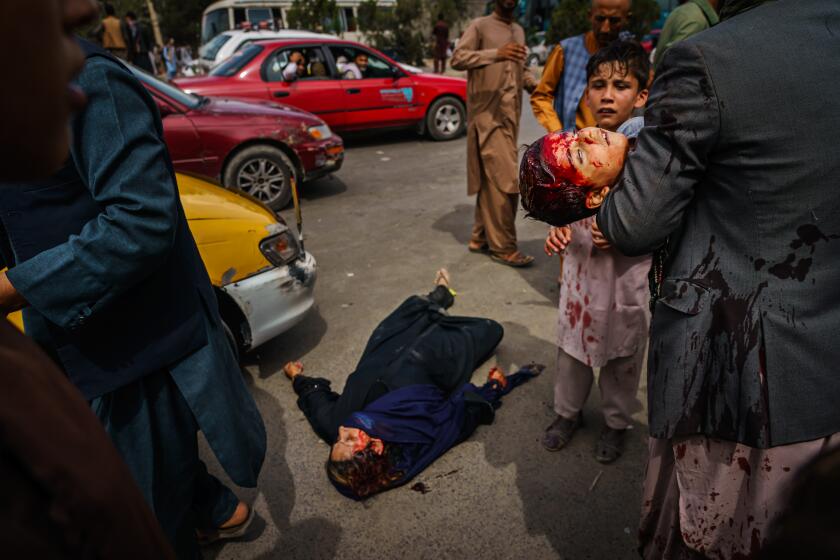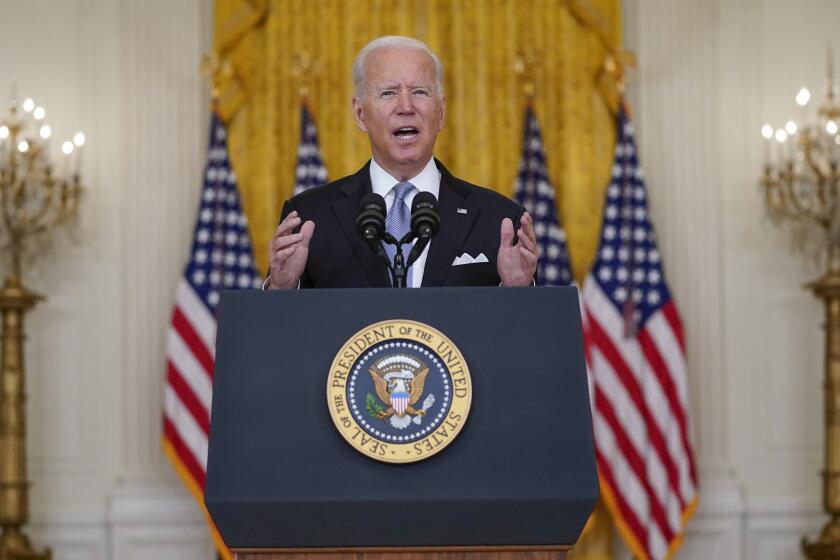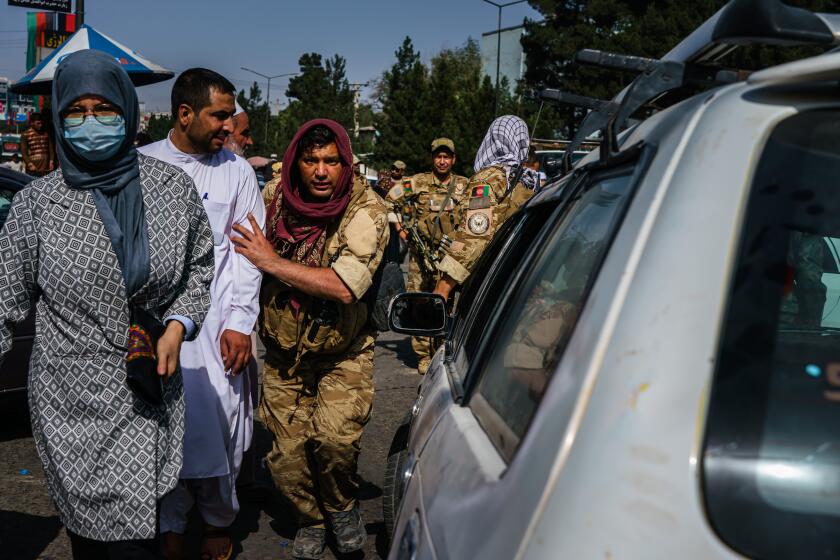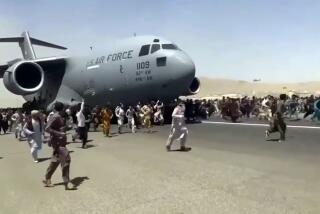Frantic rescue is underway in Kabul, but White House can’t say how long it will last
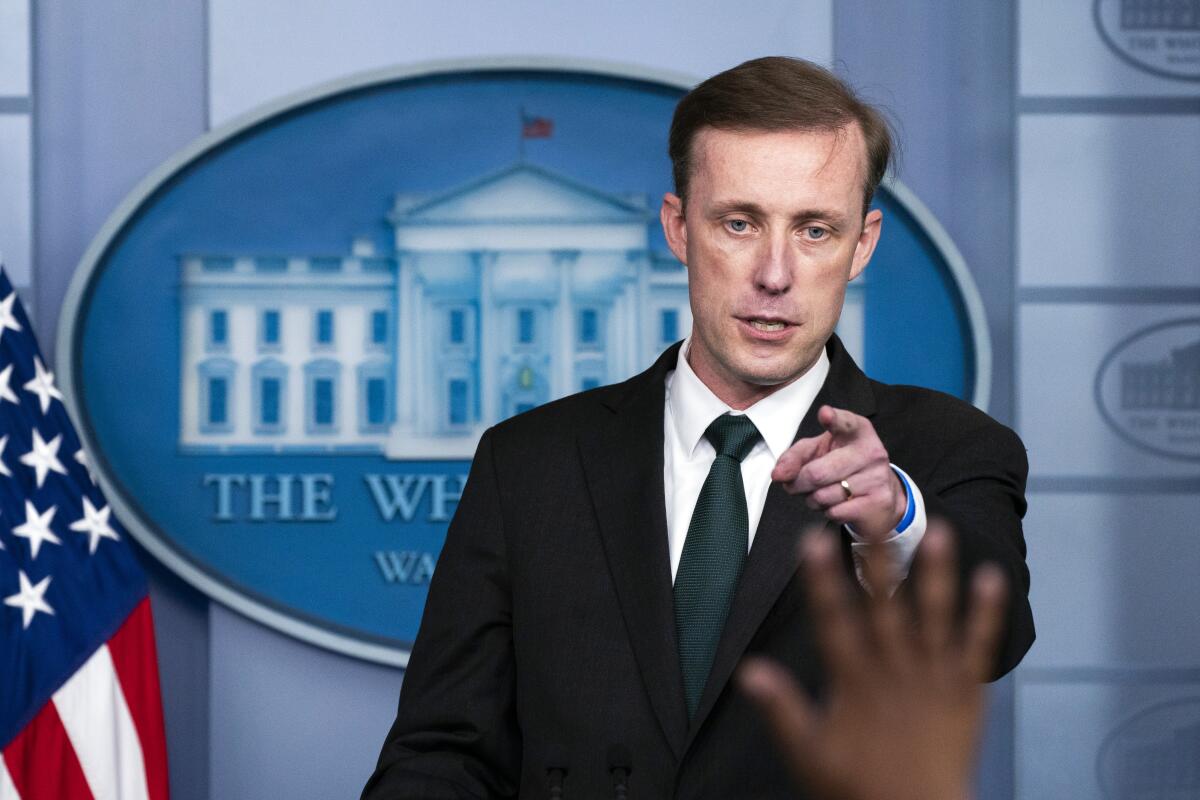
WASHINGTON — Biden administration officials said Tuesday the rescue operation underway to evacuate American citizens and vulnerable Afghan nationals from Kabul was evidence of its commitment to resolve a growing humanitarian crisis, but they would not guarantee the effort would continue beyond the end of the month.
That could leave thousands of Afghans who served alongside U.S. forces over the last 20 years behind, at risk of violent retribution from the country’s new Taliban leadership.
President Biden’s national security advisor, Jake Sullivan, told reporters at the White House that the U.S. was in contact with the Taliban, which has guaranteed safe passage to the airport for those who want to leave Afghanistan. He declined to say whether rescue operations would continue after Aug. 31, Biden’s deadline for the Pentagon to complete the drawdown of U.S. troops.
The Taliban swept into Kabul and seized power on Sunday after President Ashraf Ghani fled the country.
“I’m not going to comment on hypotheticals,” Sullivan said. “I’m going to stay focused on the task at hand, which is getting as many people out as rapidly as possible, and we will take that day by day.”
As the Taliban barreled into Kabul over the weekend, sooner than the administration had anticipated, the president dispatched U.S. forces to secure the Afghan capital’s airport and carry out the evacuation.
The swift mobilization of the Army’s 82nd Airborne, Sullivan said, showed the administration had, as Biden said in a defiant speech Monday, planned “for every contingency.” Many Republicans and Democrats contend, however, that the need for the 11th-hour rescue operation revealed otherwise.
President Biden addressed the American people about the messy U.S. pullout from Afghanistan. He stood by his decision and said there was no good time to leave.
Over 4,000 American troops have arrived in Kabul, according to the Pentagon. The U.S. military evacuated over 1,100 U.S. citizens, U.S. permanent residents and their families Tuesday, for a total of 3,200 people airlifted out of Afghanistan, the White House said.
Nearly 2,000 Afghans who assisted the U.S. military and government have been relocated to the U.S., the administration said.
It’s unclear how many people can be evacuated in the next two weeks. Over 11,000 American citizens are in Afghanistan, according to White House Press Secretary Jen Psaki. And at least 30,000 Afghan nationals who aided the U.S. effort over the last two decades are desperate to flee.
“Our plan is to safely evacuate the people who worked with us,” Sullivan said. “We are making provisions to have them come to the airport and get on evacuation flights.… between now and the end of the month.”
Sen. Ben Sasse (R-Neb.) called the response “unacceptable” in a blistering statement. “The White House’s politically-driven timetable cannot outweigh American lives,” he said. “America’s message, to our friends and to the Taliban, should be crystal clear: We will move heaven and earth to get every last American in Afghanistan back to American soil, period.”
A bipartisan group of 44 lawmakers, in an open letter, urged the president to extend the deadline for a full withdrawal and “stay as long as necessary” to evacuate not just those who assisted the U.S., but all “vulnerable Afghans.” The letter, written by Rep. Tom Malinowski (D-N.J.), said it would be “unconscionable and devastating to our credibility to leave our allies behind, given the commitments we have made.”
Although Sullivan said Tuesday that the State Department had accelerated the process for special immigrant visas, relatively few applicants have successfully navigated a bureaucratic thicket complicated by the rushed drawdown of the U.S. Embassy in Kabul.
On Monday night, Biden freed up $500 million from an emergency fund for refugees due to the crisis.
In a joint letter Tuesday, 43 Democrats and three Republicans urged the administration to create a new category of “humanitarian parole” for Afghan women, civil leaders and others especially vulnerable to the Taliban. The lawmakers also urged the White House to “streamline the paperwork process to allow for fast, humane and efficient relocation to the United States.”
A successful airlift of tens of thousands of Afghans could allow Biden to tamp down the criticism, at least from Democrats, over the miscalculations of the withdrawal. But it’s unclear how far the administration might go to ensure that Biden makes good on his vow not to leave America’s wartime allies behind.
Deadly chaos as thousands of Afghans swarm Kabul’s airport to try to flee following Taliban takeover, while others hunker down in homes.
Echoing the president, who in Monday’s address accepted responsibility for the withdrawal but not the messy exit, Sullivan focused on his boss’ rationale for ending U.S. military operations in Afghanistan.
“We’re all contending with the human costs of these developments,” Sullivan said, acknowledging recent “heartbreaking” images of Afghans grabbing onto the fuselage and wheels of a departing C-17 military transport plane. “But President Biden had to think about the human cost of [keeping forces in Afghanistan] as well.”
And, like Biden, he was blunt in portraying the recent chaos as the inevitable consequence of the former Afghan government’s collapse.
“When a civil war comes to an end with an opposing force marching on the capital, there are going to be scenes of chaos,” Sullivan said. “There are going to be lots of people leaving the country. That is not something that can be fundamentally avoided.”
